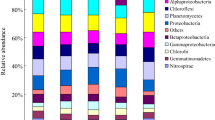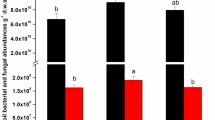Abstract
Purpose
Long-term fertilization can influence soil biological properties and relevant soil ecological processes with implications for sustainable agriculture. This study determined the effects of long-term (>25 years) no fertilizer (CK), chemical fertilizers (NPK) and NPK combined with rice straw residues (NPKS) on soil bacterial and fungal community structures and corresponding changes in soil quality.
Materials and methods
Soil samples were collected from a long-term field site in Wangcheng County established in 1981 in subtropical China between mid summer and early autumn of 2009. Terminal restriction fragment length polymorphism (T-RFLP) and the real-time quantitative polymerase chain reaction (real-time qPCR) of bacterial and fungal community and microbial biomass (MB-C, -N and -P) were analyzed.
Results and discussion
Redundancy analysis of the T-RFLP data indicated that fertilization management modified and selected microbial populations. Of the measured soil physiochemical properties, soil organic carbon was the most dominant factors influencing bacterial and fungal communities. The bacterial and fungal diversity and abundance all showed increasing trends over time (>25 years) coupling with the increasing in SOC, total N, available N, total P, and Olsen P in the fertilized soils. Compared to chemical fertilizer, NPKS resulted in the greater richness and biodiversity of the total microbial community, soil organic C, total N, MB-C, -N and -P. The high biodiversity of microbial populations in NPKS was a clear indication of good soil quality, and also indicated higher substrate use efficiency and better soil nutrient supplementation. Otherwise, unfertilized treatment may have a soil P limitation as indicated by the high soil microbial biomass N: P ratio.
Conclusion
Our results suggest that NPKS could be recommended as a method of increasing the sustainability of paddy soil ecosystems.


Similar content being viewed by others
References
Amaya-Carpio L, Davies FT, Fox T, He C (2009) Arbuscular mycorrhizal fungi and organic fertilizer influence photosynthesis, root phosphatase activity, nutrition, and growth of Ipomoea carnea ssp. Fistulosa Photosynthetica 47:1–10
Amman RI, Ludwig W, Schleifer KH (1995) Phylogenetic identification and in situ detection of individual microbial cells without cultivation. Microbiol Rev 59:143–169
Asakawa S, Kimura M (2008) Comparison of bacterial community structures at main habitats in paddy field ecosystem based on DGGE analysis. Soil Biol Biochem 40:1322–1329
Asari N, Ishihara R, Nakajima Y, Kimura M, Asakawa S (2007) Succession and phylogenetic composition of eubacterial communities in rice straw during decomposition on the surface of paddy field soil. Soil Sci Plant Nutr 53:56–65
Bell T, Newman JA, Silverman BW, Turner SL, Lilley AK (2005) The contribution of species richness and composition to bacterial services. Nature 436:1157–1160
Bremner JM (1965) Total nitrogen. In: Black CA (ed) Methods of soil analysis, vol 2, American Society of Agronomy. Madison, WI, pp 1149–1178
Brundrett MC (2002) Coevolution of roots and mycorrhizas of land plants. New Phytol 154:275–304
Cardinale BJ, Srivastava DS, Duffy JE, Wright JP, Downing AL, Sankaran M, Jouseau C (2006) Effects of biodiversity on the functioning of trophic groups and ecosystems. Nature 443:989–992
Chen Z, Luo X, Hu R, Wu M, Wu J, Wei W (2010) Impact of long-term fertilization on the composition of denitrifier communities based on nitrite reductase analyses in a paddy soil. Microb Ecol 60:850–861
Cleveland CC, Liptzin D (2007) C:N:P stoichiometry in soils: is there a “Redfield ratio” for the microbial biomass? Biogeochemistry 85:235–252
Colwell JD (1963) The estimation of phosphorus fertilizer requirements of wheat in southern New South Wales by soil analysis. Aust J Exp Agric Anim Husb 3:190–197
Costa AL, Paixão SM, Caçador I, Carolino M (2007) CLPP and EEA profiles of microbial communities in salt marsh sediments. J Soil Sediment 7:418–425
Das S, Bhattacharyya P, Adhya TK (2011) Impact of elevated CO2, flooding, and temperature interaction on heterotrophic nitrogen fixation in tropical rice soils. Biol Fertil Soils 47:25–30
De Boer W, Folman LB, Summerbell RC, Boddy L (2005) Living in a fungal world: impact of fungi on soil bacterial niche development. FEMS Microb Rev 29:795–811
Embley MT, Hirt RP, Williams DM (1994) Biodiversity at the molecular level: the domains, kingdoms and phyla of life. Philos Trans R Soc London B Biol Sci 345:21–33
Filip Z (2002) International approach to assessing soil quality by ecologically related biological parameters. Agric Ecos Environ 88:169–174
Gardes M, Bruns TD (1993) ITS primers with enhanced specificity for basidiomycetes: application to the identification of mycorrhiza and rusts. Mol Ecol 2:113–118
Ge TD, Nie SA, Wu JS, Xiao HA, Hong Y, Wang S, Kozo I, Huang DF (2011) Chemical properties, microbial biomass, and activity differ between soils of organic and conventional horticultural systems under greenhouse and open field management. J Soils Sediments 11:25–36
González-Chávez MCA, Aitkenhead-Peterson JA, Gentry TJ, Zuberer D, Hons F, Loeppert R (2010) Soil microbial community, C, N, and P responses to long-term tillage and crop rotation. Soil Tillage Res 106:285–293
Harris J (2009) Soil microbial communities and restoration ecology: facilitators or followers? Science 325:573–574
He JZ, Zheng Y, Chen CR, He YQ, Zhang LM (2008) Microbial composition and diversity of an upland red soil under long-term fertilization treatments as revealed by culture-dependent and culture-independent approaches. J Soil Sediment 8:349–358
Kamaa M, Mburu H, Blanchart E, Chibole L, Chotte JL, Kibunja C, Lesueur D (2011) Effects of organic and inorganic fertilization on soil bacterial and fungal microbial diversity in the Kabete long-term trial. Kenya Biol Fert Soils 47:315–321
Karlen DL, Mausbach MJ, Doran JW, Cline RG, Harris RF, Schuman GE (1997) Soil quality: a concept, definition, and framework for evaluation. Soil Sci Soc Am J 61:4–10
Keeney DR, Nelson DW (1982) Nitrogen inorganic forms. In: Page AL, Miller RH, Keeney DR (eds) Methods of soil analysis. Agronomy monograph 9 part 2, 2nd edn. American Society of Agronomy, Madison, pp 643–698
Kent AD, Smith DJ, Benson BJ, Triplett EW (2003) Web-based phylogenetic assignment tool for analysis of terminal restriction fragment length polymorphism profiles of microbial communities. Appl Environ Microbiol 69:6768–6776
Kitts CL (2001) Terminal restriction fragment patterns, a tool for comparing microbial communities and assessing community dynamics. Curr Issues Intest Microbiol 2:17–25
Lane DJ (1991) 16S/23S rRNA sequencing. In: Stackebrant E, Goodfellow M (eds) Nucleic acid techniques in bacterial systematics. Wiley, New York, USA, pp 115–175
Liu M, Feng H, Chen X, Huang Q, Jiao J, Zhang B, Li H (2009) Organic amendments with reduced chemical fertilizer promote soil microbial development and nutrient availability in a subtropical paddy field: the influence of quantity, type and application time of organic amendments. Appl Soil Ecol 42:166–175
Lukow T, Dunfield PF, Liesack W (2000) Use of the T-RFLP technique to assess spatial and temporal changes in the bacterial community structure with in an agricultural soil planted with transgenic and no transgenic potato plants. FEMS Microbiol Ecol 32:241–247
Malý S, Královec J, Hampel D (2009) Effects of long-term mineral fertilization on microbial biomass, microbial activity, and the presence of r- and K-strategists in soil. Biol Fertil Soils 45:753–760
Melero S, Madejon E, Herencia JF, Ruiz JC (2008) Effect of implementing organic farming on chemical and biochemical properties of an irrigated loam soil. Agron J 100:136–144
Nakayama N, Okabe A, Toyota K, Kimura M, Asakawa S (2006) Phylogenetic distribution of bacteria isolated from the floodwater of a Japanese paddy field. Soil Sci Plant Nutr 52:305–312
Nelson DW, Sommers LE (1982) Total carbon, organic carbon and organic matter. In: Page AL, Miller RH, Keeny DR (eds) Methods of soil analysis. Part 2, 2nd edn. American Society of Agronomy, Madison, pp 539–577
O’Donnell AG, Görres HE (1999) 16S rDNA methods in soil microbiology. Curr Opin Biotechnol 10:225–229
O’Donnell AG, Young IM, Rushton SP, Shirley MD, Crawford JW (2007) Visualization, modelling and prediction in soil microbiology. Nat Rev Microbiol 5:689–699
Parrent JL, Vilgalys R (2007) Biomass and compositional responses of ectomycorrhizal fungal hyphae to elevated CO2 and nitrogen fertilization. New Phytol 176:164–174
Peixoto RS, Coutinho HLC, Madari B, Machado PLOA, Rumjanek NG, Elsas JD, Seldin L, Rosado AS (2006) Soil aggregation and bacterial community structure as affected by tillage and cover cropping in the Brazilian Cerrados. Soil Tillage Res 90:16–28
Rui J, Peng J, Lu Y (2009) Succession of bacterial populations during plant residue decomposition in rice field soil. Appl Environ Microbiol 75:4879–4886
Saha S, Prakash V, Kundu S, Kumar N, Minna BL (2008) Soil enzymatic activity as affected by long term application of farm yard manure and mineral fertilizer under a rainfed soybean-wheat system in N-W Himalaya. Eur J Soil Biol 44:309–315
Semenov AM (1991) Physiological bases of oligotrophy of microorganisms and the concept of microbial community. Microb Ecol 22:239–247
Shannon CE (2001) A mathematical theory of communication. ACM SIGMOBILE Mob Comp Comm Rev 5:3–55
Shen JP, Zhang LM, Guo JF, Ray JL, He JZ (2010) Impact of long-term feritilization practices on the abundance and composition of soil bacterial communities in Northeast China. Appl Soil Ecol 46:119–214
Steenwerth KL, Jackson LE, Calderón FJ, Stromberg MR, Scowd KM (2003) Soil microbial community and land use history in cultivated and grassland ecosystems of coastal California. Soil Biol Biochem 34:1599–1611
Sugano A, Tsuchimoto H, Tun CC, Asakawa S, Kimura M (2005) Succession and phylogenetic profile of eubacterial communities in rice straw incorporated into a rice field: estimation by PCR-DGGE analysis. Soil Sci Plant Nutr 51:51–60
Tanaka H, Kyaw K, Toyota K, Motobayashi T (2010) Influence of application of rice straw, farmyard manure, and municipal biowastes on nitrogen fixation, soil microbial biomass N, and mineral N in a model paddy microcosm. Biol Fert Soils 42:501–505
Tilman D, Cassman KG, Matson PA, Naylor R, Poolasky S (2002) Agricultural sustainability and intensive production practices. Nature 418:671–677
Van Der Heijden MGA, Bardgett RD, Van Straalen NM (2008) The unseen majority: soil microbes as drivers of plant diversity and productivity in terrestrial ecosystems. Ecol Lett 11:296–310
van Veen JA, van Overbeek LS, van Elsas JD (1997) Fate and activity of microorganisms following release into soil. Microbiol Mol Biol Rev 61:121–135
Vance ED, Brookes PC, Jenkinson DS (1987) Microbial biomass measurements in forest soils: determination of kc values and tests of hypotheses to explain the failure of the chloroform fumigation–incubation method in acid soils. Soil Biol Biochem 19:689–696
White TJ, Bruns TD, Lee S, Taylor J (1990) Analysis of phylogenetic relationships by amplification and direct sequencing of ribosomal RNA genes. In: Innis MA, Gelfand DH, Sninsky JJ, White TJ (eds) PCR protocols: a guide tomethods and applications. Academic Press, NewYork, USA, pp 315–322
Wu J (2011) Carbon accumulation in paddy ecosystems in sub-tropical China: evidence from landscape studies. Eur J Soil Sci 62:29–34
Wu J, Joergensen RG, Pommerening B, Chaussod R, Brookes PC (1990) Measurement of soil microbial biomass C by fumigation-extraction-an automated procedure. Soil Biol Biochem 22:1167–1169
Wu MN, Qin HL, Chen Z, Wu JS, Wei WX (2011) Effect of long-term fertilization on bacterial compositionin rice paddy soil. Biol Fert Soils 47:397–405
Yuan HZ, Ge TD, Chen CY, O’Donnell AG, Wu JS (2012a) Microbial autotrophy plays a significant role in the sequestration of soil carbon. Appl Environ Microbiol 78:2328–2336
Yuan HZ, Ge TD, Wu XH, Liu SL, Tong CL, Qin HL, Wu MN, Wei WX, Wu JS (2012b) Long-term field fertilization alters the diversity of autotrophic bacteria based on the ribulose-1,5-biphosphate carboxylase/oxygenase (RubisCO) large-subunit genes in paddy soil. Appl Microbiol Biotechnol 95:1061–1071
Acknowledgments
This study was jointly supported by the National Natural Science Foundation of China (41271279; 41090283), International S&T cooperation program of China (2011DFA30770), Open Fund from State Key Laboratory of Soil Erosion and Dryland Farming on the Loess Plateau (10501–1213) and .the CAS/SAFEA International Partnership Program for Creative Research Teams (KZCX2-YW-T07; 20100491005–8).
Author information
Authors and Affiliations
Corresponding authors
Additional information
Responsible editor: Chengrong Chen
Rights and permissions
About this article
Cite this article
Yuan, H., Ge, T., Zhou, P. et al. Soil microbial biomass and bacterial and fungal community structures responses to long-term fertilization in paddy soils. J Soils Sediments 13, 877–886 (2013). https://doi.org/10.1007/s11368-013-0664-8
Received:
Accepted:
Published:
Issue Date:
DOI: https://doi.org/10.1007/s11368-013-0664-8




